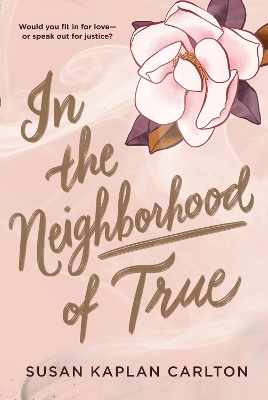Reviewed by girlinthepages on
For a story that clocks in at just over 300 pages, In the Neighborhood of True covers a LOT of themes and social issues. First and foremost, it covers the struggle of protagonist Ruth has with her identity, of being a Jewish teenager from New York transplanted into Atlanta-n high society after the death of her father, when her mother moves them back to her hometown. While Ruth is enraptured by the South and the pastel dresses, pre-debutante balls and country clubs, she also must deal with the racism and discrimination that's more obvious in her new home state than it was in New York, and determine where she wants to fit in among a society of socialites where she'll never truly be able to admit her heritage and be accepted. While I didn't always like the decisions Ruth made, I thought her struggle as a teenager in her situation was realistic and that she was at times (realistically) selfish and shallow and wanting desperately to fit in, but at her core struggled with her morals and beliefs and how they were compromised by her new social circle. This story is very much a coming of age tale that shows both the wise and selfish choices of the protagonist.
As the story is set in 1958, the racism and segregation faced by Black Atlantans cannot be ignored and I'm glad the author tackled these topics as well as the oppression and discrimination against Jewish citizens. Ruth's Rabbi is one of the leaders in the city spearheading the desegregation movement, and though Ruth wants to fit in with the "pastel posse," she finds herself still being drawn to social justice causes and uncomfortable with the casual racism she encounters everyday (and gets called out on her own problematic behavior a time or two as well). Ruth definitely goes through a "coming of age" journey in this book and her relationship with her Jewish identity evolves over the course of the novel.
One thing that really stood out to be about the writing in this story was how vivid the setting was and how clearly I could picture the scenes. I felt like I was lying poolside in the hot Southern sun drinking Coke and could easily imagine throwing a casual "say hey!" over my shoulder to an acquaintance. The author did a wonderful job in creating an authentic atmosphere though the descriptions, character thought processes, and dialogue.
One element I wasn't expecting was the the novel opens and closes with a court case, and the story itself of Ruth moving and settling into Atlanta is told in between to give context to the trial. The court case revolves around the actual bombing of a synagogue in Atlanta in the 1950s that had a huge impact on the city and the country, which the author covers in the author's note at the end of the book. I always enjoy historical fiction that covers events and happenings that perhaps do not get as much attention as others.
Overall: In the Neighborhood of True is a quick read that covers several important social issues in 1950s Atlanta, and does a good job of juggling multiple historical issues. While I do wish the book had been a bit longer, I enjoyed the novel and it's rekindled my desire to pick up more historical fiction!This review was originally posted on Girl in the Pages
Reading updates
- Started reading
- Finished reading
- 16 December, 2018: Reviewed
